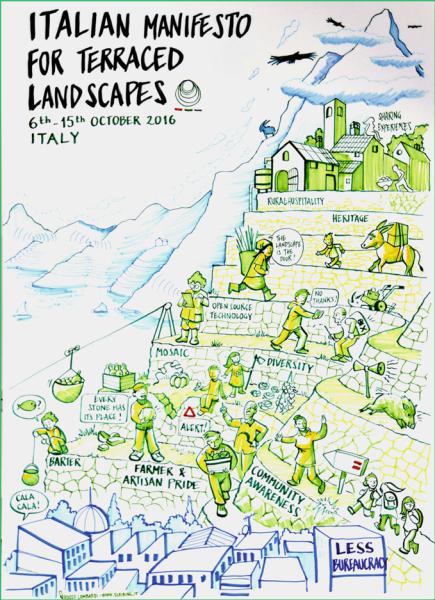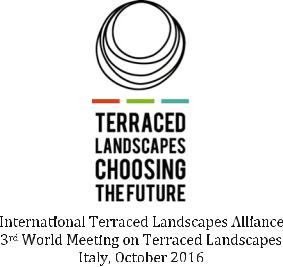
- •Series Editor’s Preface
- •Contents
- •Contributors
- •1 Introduction
- •References
- •2.1 Methodological Introduction
- •2.2 Geographical Background
- •2.3 The Compelling History of Viticulture Terracing
- •2.4 How Water Made Wine
- •2.5 An Apparent Exception: The Wines of the Alps
- •2.6 Convergent Legacies
- •2.7 Conclusions
- •References
- •3.1 The State of the Art: A Growing Interest in the Last 20 Years
- •3.2 An Initial Survey on Extent, Distribution, and Land Use: The MAPTER Project
- •3.3.2 Quality Turn: Local, Artisanal, Different
- •3.3.4 Sociability to Tame Verticality
- •3.3.5 Landscape as a Theater: Aesthetic and Educational Values
- •References
- •4 Slovenian Terraced Landscapes
- •4.1 Introduction
- •4.2 Terraced Landscape Research in Slovenia
- •4.3 State of Terraced Landscapes in Slovenia
- •4.4 Integration of Terraced Landscapes into Spatial Planning and Cultural Heritage
- •4.5 Conclusion
- •Bibliography
- •Sources
- •5.1 Introduction
- •5.3 The Model of the High Valleys of the Southern Massif Central, the Southern Alps, Castagniccia and the Pyrenees Orientals: Small Terraced Areas Associated with Immense Spaces of Extensive Agriculture
- •5.6 What is the Reality of Terraced Agriculture in France in 2017?
- •References
- •6.1 Introduction
- •6.2 Looking Back, Looking Forward
- •6.2.4 New Technologies
- •6.2.5 Policy Needs
- •6.3 Conclusions
- •References
- •7.1 Introduction
- •7.2 Study Area
- •7.3 Methods
- •7.4 Characterization of the Terraces of La Gomera
- •7.4.1 Environmental Factors (Altitude, Slope, Lithology and Landforms)
- •7.4.2 Human Factors (Land Occupation and Protected Nature Areas)
- •7.5 Conclusions
- •References
- •8.1 Geographical Survey About Terraced Landscapes in Peru
- •8.2 Methodology
- •8.3 Threats to Terraced Landscapes in Peru
- •8.4 The Terrace Landscape Debate
- •8.5 Conclusions
- •References
- •9.1 Introduction
- •9.2 Australia
- •9.3 Survival Creativity and Dry Stones
- •9.4 Early 1800s Settlement
- •9.4.2 Gold Mines Walhalla West Gippsland Victoria
- •9.4.3 Goonawarra Vineyard Terraces Sunbury Victoria
- •9.6 Garden Walls Contemporary Terraces
- •9.7 Preservation and Regulations
- •9.8 Art, Craft, Survival and Creativity
- •Appendix 9.1
- •References
- •10 Agricultural Terraces in Mexico
- •10.1 Introduction
- •10.2 Traditional Agricultural Systems
- •10.3 The Agricultural Terraces
- •10.4 Terrace Distribution
- •10.4.1 Terraces in Tlaxcala
- •10.5 Terraces in the Basin of Mexico
- •10.6 Terraces in the Toluca Valley
- •10.7 Terraces in Oaxaca
- •10.8 Terraces in the Mayan Area
- •10.9 Conclusions
- •References
- •11.1 Introduction
- •11.2 Materials and Methods
- •11.2.1 Traditional Cartographic and Photo Analysis
- •11.2.2 Orthophoto
- •11.2.3 WMS and Geobrowser
- •11.2.4 LiDAR Survey
- •11.2.5 UAV Survey
- •11.3 Result and Discussion
- •11.4 Conclusion
- •References
- •12.1 Introduction
- •12.2 Case Study
- •12.2.1 Liguria: A Natural Laboratory for the Analysis of a Terraced Landscape
- •12.2.2 Land Abandonment and Landslides Occurrences
- •12.3 Terraced Landscape Management
- •12.3.1 Monitoring
- •12.3.2 Landscape Agronomic Approach
- •12.3.3 Maintenance
- •12.4 Final Remarks
- •References
- •13 Health, Seeds, Diversity and Terraces
- •13.1 Nutrition and Diseases
- •13.2 Climate Change and Health
- •13.3 Can We Have Both Cheap and Healthy Food?
- •13.4 Where the Seed Comes from?
- •13.5 The Case of Yemen
- •13.7 Conclusions
- •References
- •14.1 Introduction
- •14.2 Components and Features of the Satoyama and the Hani Terrace Landscape
- •14.4 Ecosystem Services of the Satoyama and the Hani Terrace Landscape
- •14.5 Challenges in the Satoyama and the Hani Terrace Landscape
- •References
- •15 Terraced Lands: From Put in Place to Put in Memory
- •15.2 Terraces, Landscapes, Societies
- •15.3 Country Planning: Lifestyles
- •15.4 What Is Important? The System
- •References
- •16.1 Introduction
- •16.2 Case Study: The Traditional Cultural Landscape of Olive Groves in Trevi (Italy)
- •16.2.1 Historical Overview of the Study Area
- •16.2.3 Structural and Technical Data of Olive Groves in the Municipality of Trevi
- •16.3 Materials and Methods
- •16.3.2 Participatory Planning Process
- •16.4 Results and Discussion
- •16.5 Conclusions
- •References
- •17.1 Towards a Circular Paradigm for the Regeneration of Terraced Landscapes
- •17.1.1 Circular Economy and Circularization of Processes
- •17.1.2 The Landscape Systemic Approach
- •17.1.3 The Complex Social Value of Cultural Terraced Landscape as Common Good
- •17.2 Evaluation Tools
- •17.2.1 Multidimensional Impacts of Land Abandonment in Terraced Landscapes
- •17.2.3 Economic Valuation Methods of ES
- •17.3 Some Economic Instruments
- •17.3.1 Applicability and Impact of Subsidy Policies in Terraced Landscapes
- •17.3.3 Payments for Ecosystem Services Promoting Sustainable Farming Practices
- •17.3.4 Pay for Action and Pay for Result Mechanisms
- •17.4 Conclusions and Discussion
- •References
- •18.1 Introduction
- •18.2 Tourism and Landscape: A Brief Theoretical Staging
- •18.3 Tourism Development in Terraced Landscapes: Attractions and Expectations
- •18.3.1 General Trends and Main Issues
- •18.3.2 The Demand Side
- •18.3.3 The Supply Side
- •18.3.4 Our Approach
- •18.4 Tourism and Local Agricultural System
- •18.6 Concluding Remarks
- •References
- •19 Innovative Practices and Strategic Planning on Terraced Landscapes with a View to Building New Alpine Communities
- •19.1 Focusing on Practices
- •19.2 Terraces: A Resource for Building Community Awareness in the Alps
- •19.3 The Alto Canavese Case Study (Piedmont, Italy)
- •19.3.1 A Territory that Looks to a Future Based on Terraced Landscapes
- •19.3.2 The Community’s First Steps: The Practices that Enhance Terraces
- •19.3.3 The Role of Two Projects
- •19.3.3.1 The Strategic Plan
- •References
- •20 Planning, Policies and Governance for Terraced Landscape: A General View
- •20.1 Three Landscapes
- •20.2 Crisis and Opportunity
- •20.4 Planning, Policy and Governance Guidelines
- •Annex
- •Foreword
- •References
- •21.1 About Policies: Why Current Ones Do not Work?
- •21.2 What Landscape Observatories Are?
- •References
- •Index
21 Integrated Policies for Terraces: The Role … |
347 |
better relate the different public policies acting upon them. Even to obtain this, the action of landscape observatories is essential, since policies do not reform by themselves.
References
Agnoletti M (ed) (2010) Paesaggi rurali storici. Per un catalogo nazionale, Laterza Baldeschi P (2001) Il Chianti fiorentino. Un progetto per la tutela del paesaggio. Laterza
Barca F (2015) Un progetto per le “aree interne” dell’Italia. In: Meloni B (ed) Aree interne e progetti d’area. Rosenberg & Sellier
Besio M (ed) (2002) Il vino del mare. Marsilio
Castiglioni B, Varotto M (2013) Paesaggio e osservatori locali. L’esperienza del Canale di Brenta. Franco Angeli
Fontanari E, Patassini D (eds) (2008) Paesaggi terrazzati dell’arco alpino. Esperienze di progetto, Marsilio
Lowi T (1972) Four systems of policy, politics, and choice. Public Adm Rev 32(4):298–310 Magnaghi A (2005) The urban village, a charter for democracy and local self-sustainable
development. Zed Books
Marson A (2016). La struttura del paesaggio. Una sperimentazione multidisciplinare per il piano della Toscana. Laterza
Putnam R (1993) Making democracy work. Civic traditions in modern Italy. Princeton University Press
Manifesto
Choosing the Future for Terraced Landscapes
© Springer Nature Switzerland AG 2019 |
349 |
M. Varotto et al. (eds.), World Terraced Landscapes: History, Environment, Quality of Life, Environmental History 9, https://doi.org/10.1007/978-3-319-96815-5

350 |
Manifesto: Choosing the Future for Terraced Landscapes |

Manifesto: Choosing the Future for Terraced Landscapes |
351 |
We, 250 people from over 20 countries, meeting in Padova in the final session of the 3rd World Meeting on Terraced Landscapes, express warm thanks to our Italian hosts for the stimulating experience of plenary discussions in Venice and Padova. We also draw encouragement and many practical ideas from the exchanges during the field visits in Costiera triestina, Topolò-Dordolla, Valstagna, ValpolicellaValdobbiadene, Trentino, Ossola valley, Canavese-Aosta valley, Chiavari-Lavagna- Vernazza, Ischia-Costiera amalfitana, Pantelleria.
We have focused our attention on the remarkable history and regional variety of terraces around the world, with a particular focus on those in Italy and Europe and have reflected with high concern and high hope upon the future of terraced landscapes. Looking across the broad heritage of terraced landscapes, we believe that the present time—after decades of abandonment and degradation processes— should be the nadir of a great U-shaped curve in the state of that heritage. We commit ourselves to start the upward trend of revival in the use and sustained management of terrace systems.
This bold commitment is justified in our view by a new valuation of the inherited stock of terraces as key part of the environmental and cultural richness of landscapes, and now capable of being used in a new and multi-functional perspective. The solutions can be based upon, and justified by, the long-term public benefits that terraced hillsides can yield: the prevention of soil erosion, the mitigation of climate change, the control of flooding and effective management of water systems; the protection and enrichment of agrobiodiversity and ecosystems; the diversification of rural economies by adding value to different food, seeds and crops; the educational value of heritage and cultural landscapes, and of the human and natural stories
352 |
Manifesto: Choosing the Future for Terraced Landscapes |
which they embody; the beauty and attraction of these landscapes for leisure and tourism. This rich range of benefits or ‘public goods’ justifies a new governance and the injection of communal resources—at local, regional, national, continental, or global scales—into the maintenance, and where necessary the redemption, of terraced lands.
We note with high interest the approach to analysis and appreciation of landscapes embodied in the European Landscape Convention, principles we can apply elsewhere in the world. By adopting the Convention, many European governments have committed themselves to identify, evaluate, and prepare objectives with full public consultation related to all the landscapes in their territory and to secure protection and management of all landscapes and promote redemptive action where that is needed. It points to the need for research and policy-making to draw on a wide range of disciplines and knowledge systems. Mapping and researches by universities and regional governments are laying the groundwork for such actions.
We recognize the central role of old and new forms of sustainable agriculture and craftsmanship (farmers, dry-stone wall builders, hobby and part-time farmers, cooperatives, and associations) in the maintenance of terraces. The adaptive knowledges of these stakeholders (o figures) should be fully recognized in debates and decision-making about the future of terraced lands.
We welcome the increasing interest in revival of abandoned terraced system. In a growing number of places, communities, local authorities and farmers are leading this revival. It is refreshing to see the commitment among young people in farming the land and call for action by local authorities and civil society to support them in these ambitions through vocational education, on-the-job training, financial support for newcomers, and other techniques. The challenge, in such regions, is to find new ways of life and viable activities, which will make good use of these resources. The viability of farms in terraced areas can be greatly enhanced by the strengthening of new economies, by adding value to local food products and the introduction of more circular systems in local economies. The quality of food production, the heritage qualities, and the environmental quality of terraces can also offer a unique experience to visitors and bring complementary income to rural economies.
We call upon international organizations, governments, local authorities, landowners, commercial interests, rural communities, peasants, artisans and other ‘hands-on’ producers, educators, researchers and all relevant stakeholders to commit themselves to the protection and long-term maintenance of terraces. They should incorporate respect for terraced landscapes in all policies and programs, notably those supporting agriculture, rural development, environmental protection, water and river catchment management, spatial and territorial planning, and regional development.
We entrust the International Terraced Landscapes Alliance to take the lead in promoting multinational exchanges of ideas and experiences and to assist the strengthening of initiatives and networks in this field.
Padua, 15th October 2016
